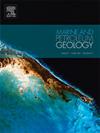美国特拉华盆地东部早二叠世Leonardian Third Bone Spring砂岩和Guadalupian Upper Avalon页岩重力流斜坡沉积的多尺度储层表征和分析:非常规资源储层的新认识
IF 3.6
2区 地球科学
Q1 GEOSCIENCES, MULTIDISCIPLINARY
引用次数: 0
摘要
德克萨斯州西部Delaware盆地的Leonardian/Guadalupian骨泉组包含两个非常规硅质泥岩储层。这些硅质泥岩层段位于砂岩三段和碳酸盐岩一段上阿瓦隆页岩。虽然以前的区域研究提供了地层对比和一般岩相描述,但本研究提供了详细的微观岩石学表征,从薄片到扫描电子显微镜,可以更详细地了解岩石组构、结构和孔隙网络。主要岩相为层状和洞状硅质泥岩交替层,间或有薄碳酸盐碎屑和浊积岩。硅质泥岩的主要特征包括:(1)总有机碳含量在1% ~ 7%之间,由ⅱ型干酪根组成;(2)地层处于生油窗内,具有良好的生烃条件;(3)硅质泥岩储集质量较好,平均孔隙度为7.6%,几何平均渗透率为0.0045毫达西(md)。层间碳酸盐岩单元非常致密,储层潜力极小。这些碳酸盐层的滑塌和破碎阻止了连续横向渗透率屏障的发育,有利于垂直渗透率。因此,在没有明显渗透率障碍的情况下,水平渗透率和垂向渗透率均较好,提高了硅质泥岩体系的储层潜力。良好的储层非均质性,加上良好的有机质含量、孔隙度和渗透率,凸显了第三骨泉和上阿瓦隆硅质泥岩的储层潜力。总体而言,leonard /Guadalupian骨泉组的硅质泥岩代表了Delaware盆地内重要的油气资源。本文章由计算机程序翻译,如有差异,请以英文原文为准。
Multiscale reservoir characterization and analysis of gravity-flow slope deposits in the early Permian Leonardian Third Bone Spring Sandstone and Guadalupian Upper Avalon Shale of the eastern Delaware Basin, U.S.A.: Insights into unconventional resource reservoirs
The Leonardian/Guadalupian Bone Spring Formation in the Delaware Basin of West Texas contains two intervals that are unconventional siliceous mudstone reservoirs. These siliceous mudstone intervals are in the Third Sandstone Member and the Upper Avalon Shale in the First Carbonate Member. While previous regional studies have provided stratigraphic correlations and general lithofacies description, this study provides detailed micropetrographic characterization, ranging from thin-section to scanning electron microscopy, enabling a more detailed understanding of rock fabrics, textures, and pore networks.
The predominant lithofacies consist of alternating beds of laminated and burrowed siliceous mudstones, punctuated by thin carbonate debrites and turbidites. Key characteristics of the siliceous mudstones include: (1) Total organic carbon content ranging from 1 to 7 wt% and composed of Type II kerogen, (2) Strata is within the oil window, indicating favorable conditions for hydrocarbon generation, and (3) Relatively good reservoir quality for siliceous mudstones, with a mean porosity of 7.6 % and a geometric-mean permeability of 0.0045 millidarcies (md). The interbedded carbonate units are notably tight, with minimal reservoir potential. Slumping and fragmentation of these carbonate layers prevent the development of continuous lateral permeability barriers, which favors vertical transmissibility. Therefore, without notable permeability barriers, the horizontal and vertical permeabilities are interpreted as good, enhancing the reservoir potential of the siliceous mudstone system. Good reservoir heterogeneity, combined with favorable organic content, porosity, and permeability, underscores the reservoir potential of the Third Bone Spring and Upper Avalon siliceous mudstones. Overall, the siliceous mudstones of the Leonardian/Guadalupian Bone Spring Formation represent a significant hydrocarbon resource play within the Delaware Basin.
求助全文
通过发布文献求助,成功后即可免费获取论文全文。
去求助
来源期刊

Marine and Petroleum Geology
地学-地球科学综合
CiteScore
8.80
自引率
14.30%
发文量
475
审稿时长
63 days
期刊介绍:
Marine and Petroleum Geology is the pre-eminent international forum for the exchange of multidisciplinary concepts, interpretations and techniques for all concerned with marine and petroleum geology in industry, government and academia. Rapid bimonthly publication allows early communications of papers or short communications to the geoscience community.
Marine and Petroleum Geology is essential reading for geologists, geophysicists and explorationists in industry, government and academia working in the following areas: marine geology; basin analysis and evaluation; organic geochemistry; reserve/resource estimation; seismic stratigraphy; thermal models of basic evolution; sedimentary geology; continental margins; geophysical interpretation; structural geology/tectonics; formation evaluation techniques; well logging.
 求助内容:
求助内容: 应助结果提醒方式:
应助结果提醒方式:


